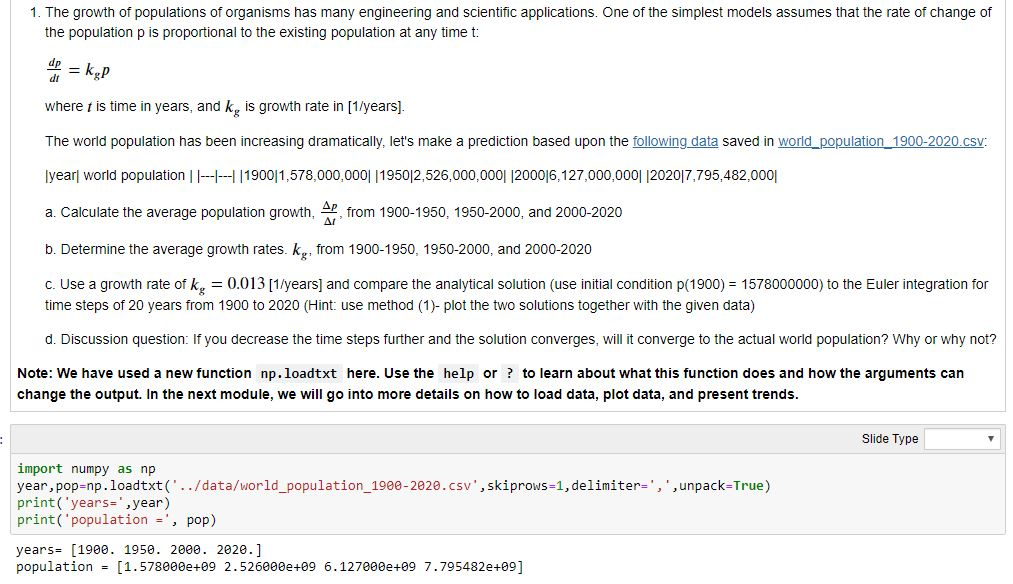 Need help utilizing Python 3 to solve these problems. Thank you.
Need help utilizing Python 3 to solve these problems. Thank you.
1. The growth of populations of organisms has many engineering and scientific applications. One of the simplest models assumes that the rate of change of the population p is proportional to the existing population at any time t: op = kgP where 1 is time in years, and k, is growth rate in (1/years). The world population has been increasing dramatically, let's make a prediction based upon the following data saved in world_population_1900-2020.csv: [year world population ---1--- 119001,578,000,000 (1950|2,526,000,000 120006,127,000,000||20207,795,482,000 a. Calculate the average population growth, from 1900-1950, 1950-2000, and 2000-2020 b. Determine the average growth rates. kg, from 1900-1950, 1950-2000, and 2000-2020 c. Use a growth rate of k, = 0.013 [1/years) and compare the analytical solution (use initial condition P(1900) = 1578000000) to the Euler integration for time steps of 20 years from 1900 to 2020 (Hint: use method (1)- plot the two solutions together with the given data) d. Discussion question: If you decrease the time steps further and the solution converges, will it converge to the actual world population? Why or why not? Note: We have used a new function np.loadtxt here. Use the help or ? to learn about what this function does and how the arguments can change the output. In the next module, we will go into more details on how to load data, plot data, and present trends. Slide Type import numpy as np year, pop-np.loadtxt('../data/world_population_1900-2020.csv', skiprows=1, delimiter=', ', unpack=True) print('years=', year) print('population =', pop) years= (1900. 1950. 2000. 2020.] population = (1.5780004+09 2.526000e+09 6.127006e+09 7.795482e+09] 1. The growth of populations of organisms has many engineering and scientific applications. One of the simplest models assumes that the rate of change of the population p is proportional to the existing population at any time t: op = kgP where 1 is time in years, and k, is growth rate in (1/years). The world population has been increasing dramatically, let's make a prediction based upon the following data saved in world_population_1900-2020.csv: [year world population ---1--- 119001,578,000,000 (1950|2,526,000,000 120006,127,000,000||20207,795,482,000 a. Calculate the average population growth, from 1900-1950, 1950-2000, and 2000-2020 b. Determine the average growth rates. kg, from 1900-1950, 1950-2000, and 2000-2020 c. Use a growth rate of k, = 0.013 [1/years) and compare the analytical solution (use initial condition P(1900) = 1578000000) to the Euler integration for time steps of 20 years from 1900 to 2020 (Hint: use method (1)- plot the two solutions together with the given data) d. Discussion question: If you decrease the time steps further and the solution converges, will it converge to the actual world population? Why or why not? Note: We have used a new function np.loadtxt here. Use the help or ? to learn about what this function does and how the arguments can change the output. In the next module, we will go into more details on how to load data, plot data, and present trends. Slide Type import numpy as np year, pop-np.loadtxt('../data/world_population_1900-2020.csv', skiprows=1, delimiter=', ', unpack=True) print('years=', year) print('population =', pop) years= (1900. 1950. 2000. 2020.] population = (1.5780004+09 2.526000e+09 6.127006e+09 7.795482e+09]
 Need help utilizing Python 3 to solve these problems. Thank you.
Need help utilizing Python 3 to solve these problems. Thank you. 





